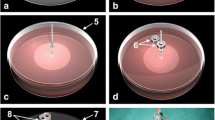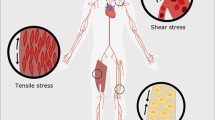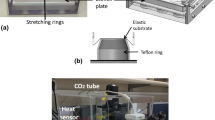Abstract
A widely used commercially available system for the investigation of mechanosensitivity applies a biaxial strain field to cells cultured on a compliant silicone substrate membrane stretched over a central post. As well as intended substrate strain, this device also provides a fluid flow environment for the cultured cells. In order to interpret the relevance of experiments using this device to the in vivo and clinical situation, it is essential to characterise both substrate and fluid environments. While previous work has detailed the substrate strain, the fluid shear stresses, to which bone cells are known to be sensitive, are unknown. Therefore, a fluid structure interaction computational fluid dynamics model was constructed, incorporating a finite element technique capable of capturing the contact between the post and the silicone substrate membrane, to the underside of which the pump control pressure was applied. Flow verification experiments using 10-μm-diameter fluorescent microspheres were carried out. Fluid shear stress increased approximately linearly with radius along the on-post substrate membrane, with peak values located close to the post edge. Changes in stimulation frequency and culture medium viscosity effected proportional changes in the magnitude of the fluid shear stress (peak fluid shear stresses varied in the range 0.09–3.5 Pa), with minor effects on temporal and spatial distribution. Good agreement was obtained between predicted and measured radial flow patterns. These results suggest a reinterpretation of previous data obtained using this device to include the potential for a strong role of fluid shear stress in mechanosensitivity.
Similar content being viewed by others
References
Baas E, Kuiper JH, Yang Y, Wood MA, El Haj AJ (2010) In vitro bone growth responds to local mechanical strain in three-dimensional polymer scaffolds. J Biomech 43: 733–739
Bacabac RG, Smit TH, Cowin SC, van Loon JJWA, Nieuwstadt FTM, Heethaar R, Klein-Nulend J (2005a) Dynamic shear stress in parallel-plate flow chambers. J Biomech 38: 159–167
Bacabac RG, Smit TH, Mullender MG, van Loon JJWA, Klein-Nulend J (2005b) Initial stress-kick is required for fluid shear stress-induced rate-dependent activation of bone cells. Ann Biomed Eng 33: 104–110
Bakker AD, Soejima K, Klein-Nulend J, Burger EH (2001) The production of nitric oxide and prostaglandin E(2) by primary bone cells is shear stress dependent. J Biomech 34: 671–677
Bhatt KA, Chang EI, Warren SM, Lin S, Bastidas N, Ghali S, Thibboneir A, Capla JM, McCarthy JG, Gurtner GC (2007) Uniaxial mechanical strain: an in vitro correlate to distraction osteogenesis. J Surg Res 143: 329–336
Bieler FH, Ott CE, Thompson MS, Seidel R, Ahrens S, Epari DR, Wilkening U, Schaser KD, Mundlos S, Duda GN (2009) Biaxial cell stimulation: a mechanical validation. J Biomech 42: 1692–1696
Brown TD, Bottlang M, Pedersen DR, Banes AJ (2000) Development and experimental validation of a fluid / structure-interaction finite element model of a vacuum-driven cell culture mechanostimulus system. Comput Methods Biomech Biomed Eng 3: 65–78
Chen X, Macica CM, Ng KW, Broadus AE (2005) Stretch-induced PTH-related protein gene expression in osteoblasts. J Bone Miner Res 20: 1454–1461
Colombo A, Cahill PA, Lally C (2008) An analysis of the strain field in biaxial flexcell membranes for different waveforms and frequencies. Proc Inst Mech Eng [H] 222: 1235–1245
Einhorn TA (1998) The cell and molecular biology of fracture healing. Clin Orthop 355(suppl): S7–S21
Ghannam MT, Esmail MN (1997) Rheological properties of carboxymethyl cellulose. J Appl Polym Sci 64: 289–301
Jacobs CR, Yellowley CE, Davis BR, Zhou Z, Cimbala JM, Donahue HJ (1998) Differential effect of steady versus oscillating flow on bone cells. J Biomech 31: 969–976
Kästner U, Hoffmann H, Dönges R, Hilbig J (1997) Structure and solution properties of sodium carboxymethylcellulose. Colloids Surf A Physicochem Eng Asp 123(124): 307–328
Liu X, Zhang X, Luo Z-P (2005) Strain-related collagen gene expression in human osteoblast-like cells. Cell Tissue Res 322: 331–334
Lonsdale RD (1993) An algebraic multigrid solver for the navier-stokes equations on unstructured meshes. Int J Num Meth Heat Fluid Flow 3: 3–14
McGarry JG, Klein-Nulend J, Mullender MG, Prendergast PJ (2005) A comparison of strain and fluid shear stress in stimulating bone cell responses—a computational and experimental study. FASEB J 19: 482–484
Owan I, Burr DB, Turner CH, Qui J, Tu Y, Onyia JE, Duncan RL (1997) Mechanotransduction in bone: osteoblasts are more responsive to fluid forces than mechanical strain. Am J Physiol 273: C810–C815
Pavalko FM, Chen NX, Turner CH, Burr DB, Atkinson S, Hsieh Y-F, Qiu J, Duncan RL (1998) Fluid shear-induced mechanical signaling in MC3T3-E1 osteoblasts requires cytoskeleton-integrin interactions. Am J Physiol Cell Physiol 275: 1591–1601
Sbalzarini IF, Koumoutsakos P (2005) Feature point tracking and trajectory analysis for video imaging in cell biology. J Struct Biol 151: 182–195
Sen A, Kallos MS, Behie LA (2002) Expansion of mammalian neural stem cells in bioreactors: effect of power input and medium viscosity. Dev Brain Res 134: 103–113
Smalt R, Mitchell FT, Howard RL, Chambers TJ (1997) Induction of NO and prostaglandin E2 in osteoblasts by wall-shear stress but not mechanical strain. Am J Physiol 237: E751–E758
Tang L, Lin Z, Li Y-M (2006) Effects of different magnitudes of mechanical strain on osteoblasts in vitro. Biochem Biophys Res Commun 344: 122–128
Vande Geest JP, Di Martino ES, Vorp DA (2004) An analysis of the complete strain field within Flexercell(TM) membranes. J Biomech 37: 1923–1928
Zienkiewicz OC (1971) The finite element method in engineering science. McGraw Hill, New York
Author information
Authors and Affiliations
Corresponding author
Rights and permissions
About this article
Cite this article
Thompson, M.S., Abercrombie, S.R., Ott, CE. et al. Quantification and significance of fluid shear stress field in biaxial cell stretching device. Biomech Model Mechanobiol 10, 559–564 (2011). https://doi.org/10.1007/s10237-010-0255-1
Received:
Accepted:
Published:
Issue Date:
DOI: https://doi.org/10.1007/s10237-010-0255-1




